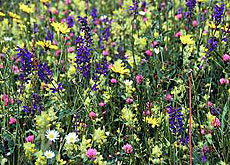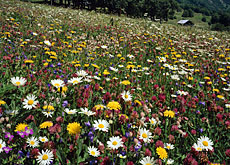Swiss biodiversity faces climate challenge

Biodiversity in Switzerland will be affected by changing temperatures but exact consequences are hard to predict, according to Swiss experts.
They also say that climate change is the biggest threat to the variety of life forms on the planet.
A recent report commissioned by the Swiss government took a closer look at climate change scenarios between now and 2050.
It concluded that one result of warmer temperatures would be the vegetation belt moving higher to colder climes. This would mean that both flora and fauna would compete for limited space, coupled with the entry of non-native species attracted by warmer climes.
The report added that certain local species might die out for various reasons, such as being unable to tolerate the increase in temperature, being forced out of their habitats by invasive newcomers or being suppressed by other local species.
It admitted however that it was difficult to predict which species might disappear from or enter Switzerland as a result of climate change.
The report would only say that local flora and fauna would resemble those in southern countries more closely.
Hard to predict
The WWF’s biodiversity expert for the alpine region, Kurt Eichenberger, told swissinfo that predicting change was virtually impossible.
“It is very hard to foresee how climate change might influence nature. The challenge will be how quickly nature adapts to changing temperatures,” he said.
However, he stressed that nature might find it easier to adapt to climate change than humans.
“Nature will adapt but it will become a problem for us to live with [climate change] because the change could be very fast. We also need to adapt to new vegetation,” he said.
“For us in [Switzerland] maybe the change won’t be as dramatic as in southern countries where there is severe desertification or the risk of it. The nutrient basis for us could be in danger.”
Pine mortality
As to how soon changes to biodiversity could take place, Eichenberger predicts that the tide could turn in 50 or even 100 years.
“It could be that pine forests in southwestern Switzerland could disappear in the next 50 years,” he said.
Eichenberger explained that there were already indications that pine mortality was on the increase in the canton of Valais due to climate change.
“An oak might replace a pine [here] but we are not sure about the next step. It could be that machia will develop in this region, which is a bush vegetation we know from the Mediterranean,” he said.
swissinfo, Faryal Mirza
The Advisory Body on Climate Change (OcCC) published a key climate report in March 2007 entitled “Switzerland in 2050”, which details the effects that rising temperatures will have on ecology, agriculture, health, tourism, water supply and infrastructure in Switzerland by 2050.
According to the authors, the Swiss can expect more frequent extreme weather patterns, resulting in floods and mudslides in winter and spring, and heatwaves in summer.
Temperatures are expected to rise by two degrees Celsius in autumn, winter and spring, and three degrees in summer, compared with 1990. The report’s authors also foresee an increase of precipitation in winter by ten per cent and decrease in summer by 20 per cent.In winter, mid-range mountain regions will receive more rain than snow, whereas those areas above 2,000 metres will get heavier snowfalls.
Overall, available water resources will dwindle. As glaciers slowly melt away, around 75 per cent of water from glaciers is expected to disappear by 2050.
Biological diversity, or biodiversity, is the number of species – animals, plants and microorganisms – found in a certain area. The concept also includes the genetic variability of these species, since no organism is absolutely identical to any other. Biodiversity also covers the variety of communities in which these species live.
The rapid decline in biodiversity worldwide is largely due to human activities: urbanisation and intensive agriculture.
At the Earth Summit in Rio in 1992 world leaders set targets to save the planet from species extinction with the Convention on Biological Diversity – a non-binding treaty which sets out goals, policies and general obligations.
Ten years later at the Johannesburg Earth Summit, they agreed to try to reverse the decline by 2010.

In compliance with the JTI standards
More: SWI swissinfo.ch certified by the Journalism Trust Initiative

You can find an overview of ongoing debates with our journalists here. Please join us!
If you want to start a conversation about a topic raised in this article or want to report factual errors, email us at english@swissinfo.ch.